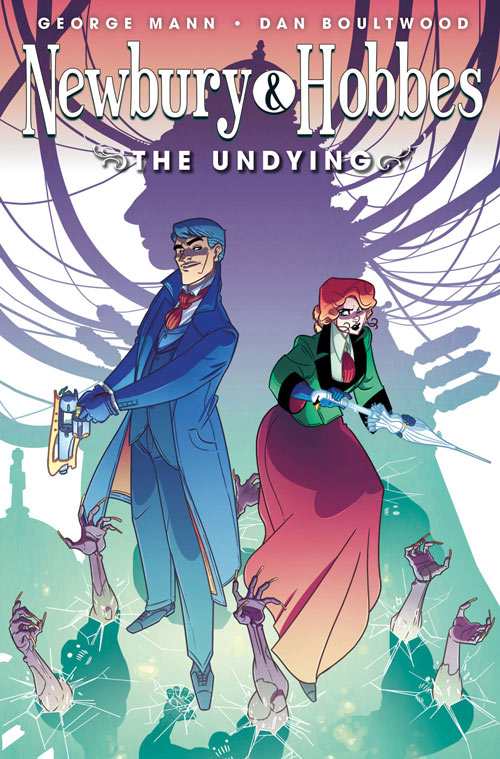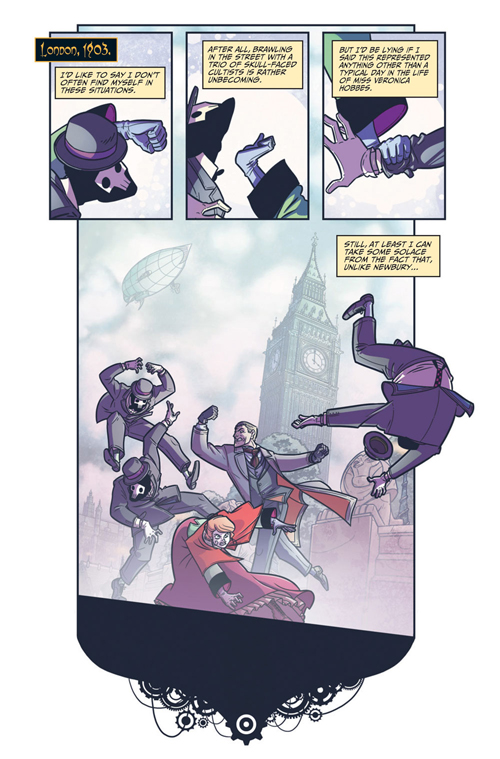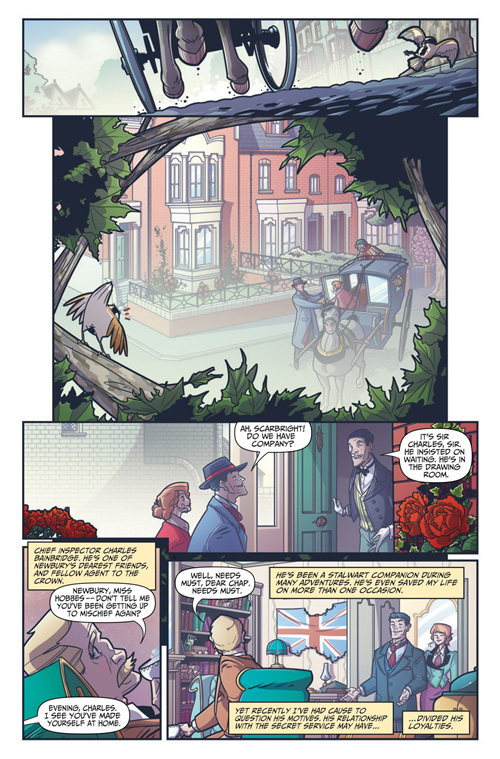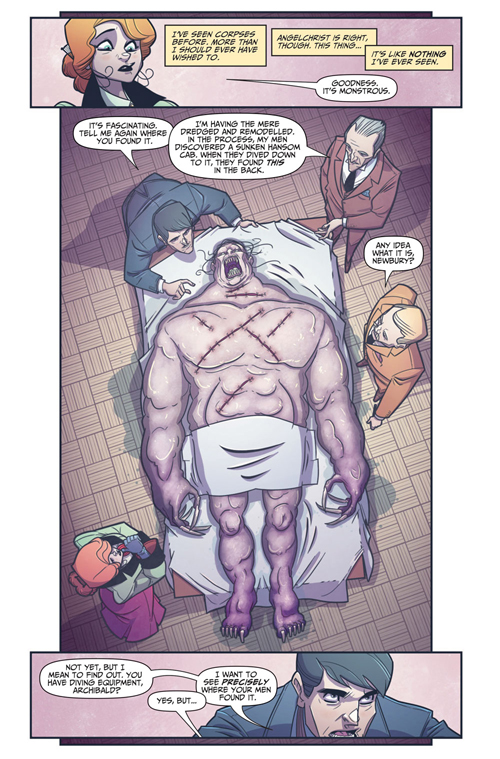Titan Comics Talks Newbury & Hobbes
Sep 05, 2018
 |
This month sees Titan Comics launch Newbury & Hobbes #1, the debut of a dynamic detective duo from darkest Victoriana. Titan Comics sat down with George Mann, writer of both the hit novels and the new comic, to discover how he’s tightening the gears on a series that will tickle the top hat of devoted fans and newcomers alike.
Newbury & Hobbes #1 (JUL182181) is in comic shops September 12.
**********
Titan Comics: Tell us about Newbury & Hobbes. Who is this dynamic detective duo? Why do your readers love them?
George Mann: The Newbury & Hobbes stories take place in an alternate history where Queen Victoria didn’t die in 1902, but instead was installed in a primitive ‘life-support’ throne, which has unnaturally sustained her, allowing her to maintain an iron grip on her ever-expanding Empire.
Sir Maurice Newbury is an agent of the Queen, charged with protecting the realm against incursions both corporeal and supernatural. Essentially, anything weird, bizarre or occult that happens, Newbury is sent in to investigate. Inevitably, this usually starts with a corpse and a mystery. Newbury has a dark side, though – he’s an opium addict, and takes a little too much of an interest in matters of the occult.
Miss Veronica Hobbes is ostensibly Newbury’s assistant, but is herself an agent of the Queen, tasked with keeping a watchful eye on Newbury and ensuring he doesn’t stray too far from the right path. She has a sister, Amelia, who suffers from clairvoyant seizures, and who has been locked away in an asylum, and Veronica is estranged from the rest of her family as a result.
The two of them are often found working alongside Chief Inspector Charles Bainbridge of Scotland Yard, who’s a masterful policeman, but has no real understanding of occult matters, and tends to call in Newbury for assistance with any matters that require a more specialized approach.
During the course of the novel series they do battle with terror birds and rogue automata, become entangled in the mystery of an airship crash, uncover a plot to assassinate the Queen, are stalked by rogue agents and assassins with clockwork hearts, recover priceless artifacts from devil-worshipping cults and generally have all manner of bizarre and thrilling adventures.
In the new comic series, The Undying, they’re facing the return of a villain who they thought to be dead, with a plan to abduct people and plant bombs in their chests, as well as uncovering the mystery behind a horrific eugenics program and the creatures that have taken up residence in the sewers beneath London.
I like to think people keep on reading the books and stories because of the characters – I think there’s a certain attraction to a flawed character such as Newbury, and a woman like Veronica, who’s essentially ahead of her time – capable, clever, strong and decisive in a time that didn’t appreciate such fine qualities.
Titan Comics: What led you to create Newbury & Hobbes? What drew you to steampunk?
George Mann: I didn’t ever set out to write steampunk. I set out to write something fun, for me; something that drew on all of my main influences and the things I loved – Hammer Horror, Sherlock Holmes, Doctor Who, Steed & Peel, Quatermass. I’d been trying for ages to write a big space opera and failing miserably – stumbling over and over again as I tried to find the heart of the story. When I told this to a friend of mine, he gave me the best piece of writing advice I’ve ever had: stop trying to please other people, and write something for yourself, just to remind yourself why you love writing.
That’s where Newbury & Hobbes came from. I set out to have fun. And it worked – I blasted through the first novel, and it all went from there. Thankfully, people seemed to like it!
I’m still not entirely sure I write steampunk, at least in the traditional sense. It’s more of a Victorian fantasy, wrapped in the aesthetic of steampunk but with a host of weird pagan and mythological stuff going on too. I’m fascinated by folklore and mythology, and that’s something I’m starting to bring into my writing more and more as time goes on.
Titan Comics: The Victorian era is packed with public domain characters, from Holmes to Dracula: what led you to create your own characters, instead of piggybacking on one of these?
George Mann: There’s nothing more liberating than creating your own characters. It enables you to tell the stories you want to tell, in the way that you want to tell them. Don’t get me wrong – I love the challenge of writing for a character such as the Doctor, or Sherlock Holmes, finding new ways to tell interesting or exciting stories in a crowded field – but I’ve always created characters and stories of my own, every since I was a child.
I’ve written three series of novels now – the Newbury & Hobbes books, the Wychwood supernatural crime stories, and a quartet of novels about a 1920s vigilante known as The Ghost. These latter books take place in the Newbury & Hobbes universe, 25 years later and across the other side of the Atlantic, but they help to form part of the backbone of the alternate history of the Twentieth Century I set out to tell when I first started writing Newbury & Hobbes.
Titan Comics: You've written both novels and comics – what would you say is the most interesting difference?
George Mann: I love writing both, but they’re very different disciplines. I think writing comics has taught me a lot about the economy of telling a story – how to boil it down to its essential components, to get right to the nub of what you’re trying to say. You can’t waffle on for too many pages. You don’t have that luxury in a 22-page comic book, where every panel counts.
I think the biggest difference for me comes in the way you address action, though. In a novel you tend to show every punch, but in a comic you tend to show the result of the action, rather than the action itself. The action is what happens between the panels. Again, it’s about economy, and about allowing the art to tell much of the story.
It’s important for me to always try to play to the strengths of the medium I’m working in, too. When I sit down to write a comic script I’m always thinking about how I can utilize the page, how I can work with the artist to create something that could only exist as a comic book.
That’s the other major difference between writing novels and comics, of course – the fact that novels tend to be personal, introverted projects, while comics are by their very nature collaborative. When you write a comic script you’re writing for the artist, who then takes that script and adds something of themselves to it, too. It’s a joyful process, and the end result is usually far greater than what I could have imagined alone.
Titan Comics: What led you to consider a Newbury & Hobbes graphic novel in the first place? Did you run into any surprises in adapting a world of your own creation into a visual format?
George Mann: It seemed like a really natural step for me. I’ve been a comic book reader most of my life, and for the last few years I’ve been busily working on comic scripts for Doctor Who, Warhammer 40,000, Dark Souls, Teenage Mutant Ninja Turtles and others. I’ve loved every minute of it, too.
Newbury & Hobbes were my first creations, though – I’ve been writing stories and novels about them for 10 years – so when the opportunity arose to tell a new story for them in comic format, it felt like a bit of a dream gig, an opportunity to do something different and hopefully introduce them to a new audience, too.
I think the biggest surprises came from seeing how Dan chose to depict the characters and their environments. I’ve been living with these characters in my head for so long that I was worried no one would be able to get it right, to depict them as I see them in my mind’s eye…and yet when Dan delivered those first few pages, I realized just how great a fit for these characters he is. He really nailed it.
Titan Comics: You worked with Titan's own Dan Boultwood on this book – was this your first time working together? How did the two of you gel?
George Mann: This was the first project I’ve worked on with Dan, and hopefully it won’t be the last. I think the two of us have a similar sensibility – Dan seemed to just ‘get’ Newbury & Hobbes from the off; the wry humor, the sense of adventure, leavened with grim, gothic horror. I think we probably share a lot of the same cultural references – Steed & Peel, Sherlock Holmes, Doctor Who.
And Dan’s a funny guy, too. The sort of person you want to drink gin with, before setting out to solve dastardly crimes.
Titan Comics: Any sneaky hints for the next Newbury & Hobbes book?
George Mann: In the previous novel, The Executioner’s Heart, readers learned that Veronica had been badly injured during a mission to stop an assassin known as the Executioner, and we left her at death’s door, locked in a coma and attached to a primitive life support system in a London basement.
In The Revenant Express, coming in February, we join Newbury and Veronica’s sister, Amelia, as they journey across Europe towards the icy fantasia of St. Petersburg, where Newbury hopes to obtain a device that will help to restore Veronica’s health.
Simultaneously, we follow a case in flashback, in which Veronica and Charles Bainbridge investigate a series of mysterious deaths in London, prior to the events that unfolded in The Executioner’s Heart. The core of the new books centers around how these two seemingly unrelated stories dovetail, and whether Newbury can prove successful in his quest to save Veronica’s life.







